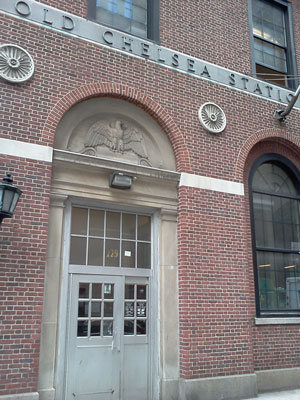
No mail on Saturdays might be the least of our problems: OCS is in cue to be relocated, if the USPS has its way.
BY SCOTT STIFFLER | Another struggling business in Chelsea may be closing its doors and moving to more modest digs. But in this particular case, the public will at least be able to weigh in on the matter. Their concerns will be voiced, beginning at 6:30pm on Thursday, April 11. That’s when, properly motivated by overtures from Community Board 4 (CB4) and a coalition of elected officials, representatives of the United States Postal Service (USPS) will attend a community meeting at the Fulton Auditorium (119 Ninth Avenue). The lone item on the agenda: discuss a plan to sell the Old Chelsea Station (OCS) Post Office.
Located at 217 West 18 Street, between Seventh and Eighth Avenues, OCS is on the National Register of Historic Places. However, according to the city’s Landmarks Preservation Commission, no part of it is landmarked, neither the exterior nor the interior. The two-story, red brick, limestone-trimmed, Colonial Revival-style 1937 structure does, however, have the distinction of being one of 29 Depression-era post offices in New York City. Amply proportioned at 41,865 square feet with a lobby accentuated by a green and buff marble floor and full-height pilasters (as well as deer and bear relief panels carved by Paul Fiene), OCS is regarded by loyal customers as both a practical necessity and local aesthetic gem.
As reported in a February 7 article (in our sister publication, The Villager), it was 79-year-old Village resident Barbara Ruether who alerted others that the historic Chelsea post office was a likely candidate for the chopping block. While at OCS on January 22 to return a package ordered online, Ruether noticed a two-page letter pinned to the wall in the entrance that referred to the proposed sale of the building. A few days later, she acquired a PDF digital copy of the letter, plus the preservation covenant attached to it, and circulated it widely via e-mail.
Shortly after Villager reporter Liza Béar filed her story, Congetta Chirichello, of USPS Corporate Communications, posted a reader comment on the Villager’s website, which explained the proposed sale of OCS (prefaced by her observations about the decline, in recent years, of a demand for USPS products and services). “By consolidating operations into a smaller space,” wrote Chirichello, “we save money and generate revenue from the sale at the same time. The community may also see a valuable property restored to its tax rolls once a new owner purchases and reuses the site.” Maintaining that the USPS is “not taking away service to the community,” Chirichello asserted, “we do need to move our operations that fit our operations in a smarter, more cost-efficient way.”
That clarity and reassurance was far from the public declaration of intent many had hoped for. On March 21, Congressman Jerrold Nadler, Congresswoman Carolyn Maloney, City Council Speaker Christine C. Quinn, Borough President Scott Stringer, State Senator Brad Hoylman and Assemblymembers Richard Gottfried and Deborah Glick issued a joint statement in which they said they were “extremely concerned by the lack of public outreach and transparency with which the USPS has operated regarding the proposed sale of the facility.” The statement went on to note that the April 11 meeting had been scheduled only after “considerable back-and-forth between elected officials and USPS, and very understandable outrage and confusion among community members.”
Speaking last week with Chelsea Now, CB4 Chair Corey Johnson recalled an appearance by USPS officials at a March 14 meeting of the Manhattan Borough Board — during which they presented on three facilities identified for relocation (OCS, the Bronx General Post Office and Peter Stuyvesant Station).
“I voiced the community’s concerns related to the lack of public notification,” said Johnson — who said that that the USPS “has tried to constitute the Borough Board meeting as a true public meeting” which would fulfill their obligation for a public review session. Johnson further observed that although “technically, the Borough Board is an open public meeting, it does not satisfy or meet the threshold of a community meeting” — since, he noted, it took place at 8:30am on a Thursday, when many potential attendees were at, or headed, to work.
Johnson also emphasized the importance of robust public attendance and participation. “It’s our goal to get folks to weigh in and hopefully save the post office in Chelsea, through community activism,” he said. Those who cannot attend the upcoming meeting at Fulton Auditorium have only a short amount of time to coordinate their efforts.
“We are deeply disappointed that USPS, after repeated requests, has only extended its public comment period to April 26,” read the joint statement by the electeds. As is, they noted, community members have just 15 days to comment following the April 11 presentation. “USPS absurdly chose to begin its 60-day comment period on February 19, well before anyone had anything concrete on which to comment,” continued the electeds’ statement. “The extension clearly shows that USPS has discretion in this matter and we, once again, call for the full 60-day comment period to begin after the public presentation.”
Until that April 26 deadline, Johnson is urging the public to “write directly to the USPS, through the Postmaster General. They should also copy our local elected officials and the Community Board.”



































